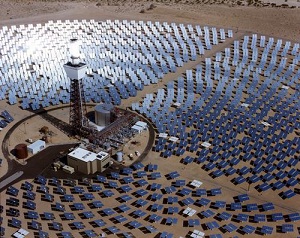Understanding Concentrated Solar Power Systems
 Concentrated solar power is one of the hot new ways (literally!) that energy companies and homeowners are looking to generate cheap, plentiful sources of renewable energy. For instance, the Odeillo-Font-Romeau Solar Furnace in France melts iron ore into steel. The structure uses 63 heilostatic (sun-tracking) mirrors that concentrate light on a large reflector. The reflector focuses all the light on a crucible which reaches 3,500 degrees Celsius.
Concentrated solar power is one of the hot new ways (literally!) that energy companies and homeowners are looking to generate cheap, plentiful sources of renewable energy. For instance, the Odeillo-Font-Romeau Solar Furnace in France melts iron ore into steel. The structure uses 63 heilostatic (sun-tracking) mirrors that concentrate light on a large reflector. The reflector focuses all the light on a crucible which reaches 3,500 degrees Celsius.
The first large-scale solar thermal power plant—using parabolic troughs—was built in 1985 (it’s still active today), but newer methods of concentrating solar power (CSP) have created power towers, which are capable of powering thousands of homes. Looking like a giant metallic flower or a satellite dish, power towers have a central tower surrounded by a massive field of heliostats. The heliostats focus all the sunlight hitting them throughout the day on the central tower. That concentrated sunlight superheats the tower and can reach temperatures like the Solar Furnace does.
Power towers differ in the use of heat transfer mediums and the types of turbines used to generate electricity. Modern power towers use molten salts as the heat transfer mechanism because it has excellent heat-retention properties, but other mediums including water and synthetic oils also have been used. The transfer medium moves the extreme heat from the tower to a heat exchanger where another substance, water or an inert gas like helium or nitrogen, is superheated to power an electricity-producing turbine.
Molten salt allows power-tower systems to store excess heat. The stored heat is moved through the heat exchanger after dark, allowing the turbine to generate electricity into the night and even overnight.
Conventional steam turbines operate at about 41 percent efficiency (this includes the steam turbines used with coal-burning power plants) at up to about 550 degrees Celsius. At temperatures above that, closed-system gas turbines systems are up to 50 percent efficient at converting heat to electricity.
You’re not going to put a power tower in your backyard or on your roof, but rooftops could reflect light onto a centralized power tower providing electricity. Smaller, CSP products will fit in your backyard. They look like mirrored, futuristic satellite dishes and concentrate sunlight on a Stirling engine to generate electricity. Such systems, according to the Department of Energy, had a net conversion efficiency of 31.25 percent as of 2007.



